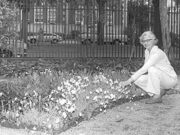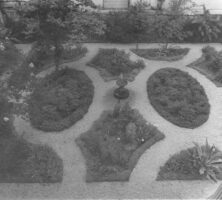Clermont Lee, one of the earliest women active in landscape architecture in Georgia, was known as the foremost expert in recreating historic landscapes in mid-twentieth-century Savannah. Her work was meticulously researched, with a particular focus on formal English and American gardens of the antebellum period. Lee was also responsible for working to found the Georgia State Board of Landscape Architects, a licensing board for landscape architects across the state. Lee was one of the first female landscape architects registered in Georgia.
Clermont Huger Lee was born in Savannah in 1914. After schooling in Savannah and Charleston, South Carolina, she attended Barnard College in New York City before transferring to Smith College in Northampton, Massachusetts, where she eventually decided to major in landscape architecture. After completing her undergraduate degree, she attended the Smith College Graduate School of Architecture and Landscape Architecture (formerly the Cambridge School), near Harvard University in Cambridge, Massachusetts, obtaining a master’s of landscape architecture degree in 1939. Though Harvard was, at this time, the center for forward-thinking Bauhaus architecture, Lee preferred traditional, less severe landscape styles.
During the Great Depression, Lee returned to Savannah to become an assistant to T. M. Baumgardner, a landscape architect associated with the Sea Island Company. While working there, she planned landscape designs and supervised planting operations for many federal housing projects in Savannah and Brunswick.
Her interest in historic gardens began in the 1940s, when, at the request of a family friend, she drew plans for a small garden at the Hofwyl-Broadfield Plantation in Brunswick. In 1944 she made measured drawings of ten Victorian gardens in Savannah for Laura Bell and the Georgia Historical Society. She later researched antebellum plantings to develop a planting plan for the formal garden of the Andrew Low home for the Georgia Chapter of the Colonial Dames of America. In 1949 Lee left the Sea Island Company to set up her own practice, thereby becoming the first female professional landscape architect in private practice in Savannah.
In the early 1950s Lee began her long involvement in historic landscapes. In addition to her work on the gardens of the Owens-Thomas House on Oglethorpe Square in Savannah, her new design and planting plans for historic buildings in the city included the birthplace of Juliette Gordon Low, the Andrew Low House, and the Green-Meldrim mansion. Outside the confines of Savannah, she consulted on the Chief Vann residence and the New Echota Cherokee capital in north Georgia for the Georgia Historical Commission.

Courtesy of Juliette Low Birthplace
From 1951 to 1972 Lee worked with Mills B. Lane Jr., the president of the Citizens and Southern Bank, and his wife to develop landscapes for renovated homes in the northeast section of Savannah. She also worked with the Lanes to develop plans for the renovation of four Savannah squares: Madison, Troup, Warren, and Washington. Her designs to preserve the sanctity of the squares brought her into conflict with the city, which wanted drive-through lanes for emergency crews and buses crossing the middle of all squares. To address the problem of the turning radius required by the buses, the city adopted Lee’s suggestion that the curves of entry into the squares be rounded. In addition, some utility poles and concrete walks were removed from the squares. Lee’s strong, simple designs used variations in materials and ground forms to give each square a special character.
In addition to becoming one of the few women in landscape architecture in Georgia, Lee also worked for recognition of her profession. When the American Society of Landscape Architects was founded in 1899, only one woman, Beatrix Farrand, from New York, was among its founding members. Lee joined the ASLA in 1950 and later worked in conjunction with Hubert Owens, head of the Department of Landscape Architecture at the University of Georgia, to establish the Georgia State Board of Landscape Architects. The first four landscape architects to be registered included Owens and Lee. Lee served on the Georgia board for three years.
Clermont Lee not only made history for women in landscape architecture but also had a lasting impact on the quality of Savannah’s historically designed landscape environment. She died in Savannah on June 14, 2006.






